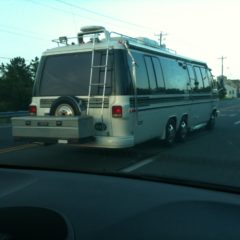Neo-Classic Car: 1987 Chevrolet Monte Carlo SS Aerocoupe
By Chris Haak
10.22.2009
There weren’t a lot of bright spots in the performance car universe in the mid-1980s. At the tail end of the malaise era, before Honda Accords had 272-horsepower V6s, Corvettes had 430 horsepower V8s standard, cars just weren’t very good. And they certainly weren’t very fast or powerful.
The Buick GNX was GM’s greatest performance car of the period and stuffed an underrated 276-horsepower turbocharged and intercooled V6 under its black, boxy body; Corvettes in 1986 produced 240 horsepower. Meanwhile, Chevrolet’s personal-luxury coupe, the Monte Carlo, carried the bowtie division’s flag for NASCAR purposes at the time, and Ford was putting its far-sleeker Thunderbird on the track against the boxy Monte Carlo.
GM figured that an easy way to improve the Monte Carlo’s aerodynamics, and continue to hold its position atop the Manufacturers’ Cup standings, would be to change the shape of the Monte Carlo’s rear end to shorten the decklid and lengthen the roofline via a re-shaped backlight treatment. GM wasn’t allowed to just change the template of the race car, though, without selling a production version, so for the 1986 model year, the company built a limited run of 200 white Monte Carlo SS Aerocoupes. Two hundred was the minimum production number required under NASCAR’s homologation requirements.
For the 1987 model year, GM produced 6,052 Aerocoupes and 33,199 non-Aerocoupe SSs. There were no 1988 Aerocoupes.
When I was a kid in Boy Scouts, the mom and step-dad of one of my fellow Scouts had a white 1987 Aerocoupe that they bought new. I still remember the license plate: HOT 87. At the time, I thought that the whole concept of the different rear window was ridiculous (I had no clue about aerodynamics at the time), and thought the car looked ridiculous. Looking at the photo above, however, the back end is probably the bestpart of the car’s profile. The worst, to me, is the absurd front overhang and generally short wheelbase. Otherwise, it’s pretty conventional fare, and GM sold a LOT of personal-luxury coupes in the early- to mid-1980s among its various divisions (Oldsmobile Cutlass Supreme, Pontiac Grand Prix, Buick Regal, plus the Monte Carlo). The Monte Carlo has the distinction of being the last rear wheel drive, body on frame, carbureted V8 car sold by GM. Think about all of the millions of cars that GM sold with those specifications over the decades – luminaries such as the 1957 Chevy and 1964 Impala come to mind immediately.
 I spotted a black 1987 Aerocoupe one day on my drive home from work and snapped the camera phone photo shown to the right. There is little that one can use to differentiate between the ultra-rare 1986 Aerocoupe from the more-common 1987 model other than the fact that 1986 cars were only available in white, and this one is clearly not white. No, I’m not a detective.
I spotted a black 1987 Aerocoupe one day on my drive home from work and snapped the camera phone photo shown to the right. There is little that one can use to differentiate between the ultra-rare 1986 Aerocoupe from the more-common 1987 model other than the fact that 1986 cars were only available in white, and this one is clearly not white. No, I’m not a detective.
Under the hood, there is a “high output” 5.0 liter (305 cubic inch) V8 coupled to a four-speed automatic. The engine is rated at an emission-choked 180 horsepower and 225 lb-ft of torque, and boasts a four-barrel carburetor. (The regular-output version of the 5.0 liter V8 was rated at 150 horsepower). More than 15 years ago, I drove a 1984 Monte Carlo SS (with a different engine, rated at 175 horsepower/230 lb-ft) for a 30-minute trip and came away completely underwhelmed. At the time, I had been used to the “high power” of a fuel-injected V6 (125-140 horsepower) that may have been down on power, but were far more responsive.
To be fair to the fourth-generation Monte Carlo SS, it’s VERY easy to soup up its engine. A 5.7 liter (350 cubic inch) small-block Chevy V8 bolts right into the car, and there are countless performance upgrades that can be done even to the stock 305 to increase its output and responsiveness many times over. Also, the 1984 model that I drove was at least 10 years old at the time, so it may have been a little tired.
According to MonteCarloSS.com, on top of the standard Monte Carlo fare, the Super Sport package of the 1980s added:
So, in spite of the car’s rather tame performance against a contemporary such as the Buick GNX, and also against modern cars when a Malibu V6 can go zero to sixty in around six seconds, it clearly had several performance upgrades to steering, suspension, engine, and appearance. In terms of fuel economy, using the 2008-equivalent numbers, a 1987 SS was rated at 15 city/22 highway. The 4.3 liter V6 powered base car was rated at 17 city/22 highway (17/24with the optional four-speed automatic).
There is still a loyal following for these cars. While their appearance may be a bit odd and their performance doesn’t hold up to modern standards, they still seem to have a chance to be true collectible cars someday in the future.
COPYRIGHT Full Metal Autos – All Rights Reserved
Note: Thanks to http://www.montecarloss.com/ for much of the background information used in this article.






